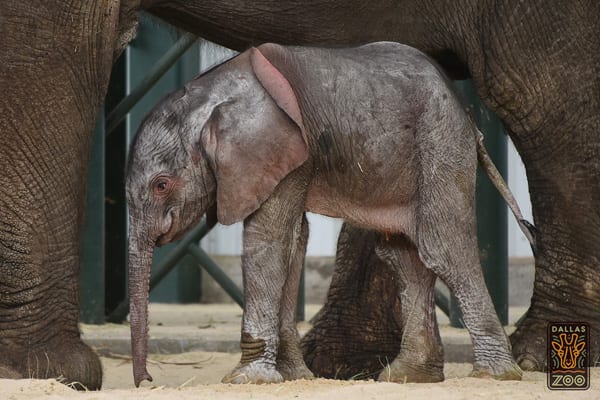 The Dallas Zoo has welcomed a big new arrival: a male African elephant calf born May 14 to Mlilo, one of the elephants rescued from drought-stricken Swaziland this spring.
The Dallas Zoo has welcomed a big new arrival: a male African elephant calf born May 14 to Mlilo, one of the elephants rescued from drought-stricken Swaziland this spring.
The calf stands about 3 feet tall, and his tiny trunk is just over a foot long. His ears are light pink, contrasting with his darker gray body. He weighs 175 pounds, which is on the low end of the 150- to 300-pound range for newborn African elephants. A low birth weight isn’t surprising, given the difficult conditions in Swaziland during his 22-month gestation.
The calf, who isn’t yet named, is active and exploring the barn, although he doesn’t get too far from mom. He’s nursing and vocalizing as expected.
“This birth validates the critical importance of our rescue efforts and why we worked so hard to get these animals to safety as quickly as possible,” said Gregg Hudson, president and CEO of the Dallas Zoo.
The birth was quick and uneventful, and the calf arrived at 10:15 p.m. For several nights, Dallas Zoo elephant keepers stayed in the barn overnight to monitor the herd round-the-clock.
“Our entire animal staff, from keepers to veterinarians to the nutrition team, is involved in caring for this remarkable calf, as well as our other nine elephants,” said Lynn Kramer, D.V.M. and vice president of Animal Operations and Welfare at the Dallas Zoo. “He is doing well; playing hard and nursing often. And Mlilo is proving to be a very attentive and patient mother.”
Mlilo (pronounced “ma-LEE-lo”) arrived in Dallas showing signs of a possible pregnancy, but all tests conducted were inconclusive. Additionally, breeding-age bull elephants in Swaziland had been vasectomized, so the chances of a pregnancy were extremely low. Regardless, the Dallas Zoo staff was careful with the day-to-day care of Mlilo, creating positive conditions for her to have a successful birth.
“The small risk of moving a potentially pregnant animal was far outweighed by the certain death she and her calf faced in Swaziland,” Hudson said. “I shudder to think what would have happened to Mlilo and her calf without the last six months of food and water we provided while they were in Swaziland, as well as the excellent care and nutrition they received upon their arrival.”
Zoo officials don’t yet know when the public will be able to see the calf. It could be several months, while mother and calf continue to bond with each other and the rest of the herd. The introduction process between the other four Swaziland elephants and the Dallas Zoo’s four well-known “Golden Girls” is continuing.
“This calf will be an excellent ambassador for his species, helping us teach guests about the grave crisis facing elephants in Africa, and inspiring them to help protect this majestic species from extinction,” Hudson said.
This is the first birth of an African elephant calf in the United States in nearly two years.
The Dallas Zoo collaborated with conservation officials in Swaziland, Africa, and two other accredited U.S. facilities to provide a safe haven for 17 African elephants. The elephants had destroyed trees and other vegetation in the managed parks where they lived, making the land uninhabitable for more critically endangered rhinos. Swaziland managers planned to cull the elephants in order to focus on rhino conservation. The zoos’ collaboration to relocate the elephants was conceived not only to save them, but to support Swaziland’s rhino conservation efforts.
In a complex process that lasted nearly two years, the Dallas Zoo, Omaha’s Henry Doorly Zoo and Wichita’s Sedgwick County Zoo applied for permission from the U.S. government to accept the animals. The permit was granted in January after extensive review, and a detailed move was planned for nearly two months. The elephants were flown to the U.S. aboard a chartered 747 jet, arriving March 11, 2016. Five of the elephants found a home in Dallas, while the other two facilities are each caring for six of the rescued animals.
In addition to Mlilo, who’s believed to be about 14 years old, the Swaziland elephants at the Dallas Zoo include bull Tendaji and females Zola, Amahle and Nolwazi. All range in age from 6 to their mid-20s. They join the zoo’s four “Golden Girls” – Jenny, Gypsy, Congo and Kamba – in the award-winning Giants of the Savanna habitat.
All three zoos have expansive new habitats that set the standard for an advanced way of managing elephants in human care, allowing for socialization, herd behavior and extensive walking. Public support for the rescue has been overwhelming, given the critical situation in the animals’ native land. African elephants face many threats, ranging from human encroachment on their habitat to extreme poaching, which claims the life of nearly 100 elephants every day.

Dallas Zoo welcomes baby elephant
















